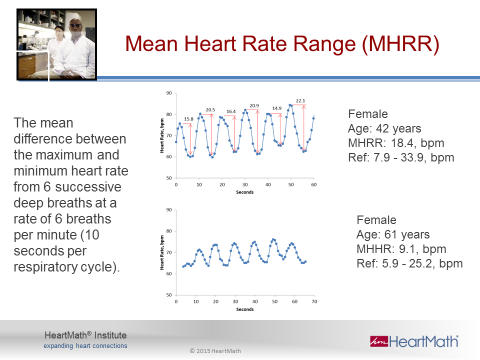- What markers are we focused on to make a call on current autonomic regulation function, where they are standing on the stress response and where they are on the fatigue/resilience spectrum.
The overall amount of HRV the person has is the best indicator of the health status of the ANS system which includes the lower levels of the brain, vagus nerves (parasympathetic) and heart. This best short-term measure we currently know of for determining overall amount of HRV is the 1-Minute Deep Breathing assessment. The main measure we recommend using is the mean heart rate range (MHRR) as it is by far the easiest to understand and explain to a client. The value of the client is compared to the database of known healthy people of the same age. The high and low cut off points of the normative range is based on 95% confidence intervals which is approximately two standard deviations above and below the mean for that age. The range is rather wide with really healthy people (athletes, health life styles, etc.) who have higher levels of HRV and resilience creating the top of the ranges and individuals who are healthy (no disease, not taking medications, etc.) but may not have as healthy of a life style, lower level so resilience, etc. who create the bottom of the reference range. If the clients value is right in the middle of the reference range, it indicates that their chronical and biological age is well matched. Ideally, the clients value or the MHRR is falls near the center or above the center of the reference range.
Although we use the 95% confidence intervals for high and low cutoff points, one standard deviation below the mean is of concern and in clinical studies has been shown to be associated with increased health risk. It the client is near the bottom of the range and certainly if they are below it, there is reason for concern and steps should be taken to find out why.
Some other considerations to keep in mind:
In the 1-minute deep breathing assessment, it’s a challenge test that asks the question, what is the maximum HRV their ANS can produce at this time. In this assessment, the HRV is generated almost entirely by the vagus system. The SDNN, RMSSD, MHRR, etc. are all very highly correlated, and any of them could be used but we recommend the MRHR as due to its simplicity in explaining to a client.
In any resting state recording, the HRV is primarily generated by the vagal parasympathetic system. The 1-minute deep breathing assessment not only has very good correlations to 24-hour measures of parasympathetic activity HF, LF, RMSSD, etc.), it also has good correlations with the VLF activity in 24-hour recordings. This is important as a low VLF is the most important in terms of being associated with future health risk.
This is not the same as in resting state recordings, where the correlations to vagal activity are still reasonable (but not as good as the deep breathing assessment) but the correlations with VLF are unacceptable. In resting state recordings the various HRV measures are not as well-correlated with each other as in the 1-Min deep breathing assessment although they tend to be significantly correlated. The VLF is not correlated and none of the measures are as well correlated with 24-hour measures.
At the individual level, the value of the MHHR (or any of them) obtained at the first recording can be compared to their value during and after the clinical intervention process. Obviously, an increase is ideal and even small gains can be meaningful (~2 BPM increase in the range).
In the 1-minute deep breathing assessment the normalized coherence measure should also be within the normative range. If is not, it indicates a lack of proper coupling between the respiratory and cardiovascular control centers in the medulla.

- SDNN is referred to as a marker for how the overall nervous system is functioning — what is the patient’s number being compared to (i.e. what’s good, what would be a concern)
In short-term resting state recordings the SDNN is correlated with the other measures. It is compared to the mean of the age-adjusted normative data base, or the clients earlier values. However, in 24-hour ambulatory recordings the SDNN is NOT correlated to measures of vagal activity (HF, RMSSD) but is correlated with VLF and ULF power. In the 24-hour assessments all values are also compared to a normative values of 24-hour measure of healthy people.
- RMSSD used for parasympathetic dominance and a capacity to regenerate — what is the patient’s number being compared to (i.e. what’s good, what suggests poor regenerative capacity?)
We don’t use the term “parasympathetic dominance.” In fact we wish to eliminate the term dominance from these type of discussions. It is a measure of parasympathetic generated activity. See above for what it is compared to.
- Referring to the total power output and LF to HF as assessing the power in the system and how the power is being distributed — in the HMIP they talked about sympathetic dominance often being the first stage of stress and what people focus on, but parasympathetic burnout being even more significant and concerning because their regenerative capacity is compromised. Can you see where a patient is standing in regards to this with the report?
In resting state recordings, both the LF and HF are vagally mediated. In the 1-min assessment the values are compared to the normative reference range. We do not provide normative data for resting state recordings, they are only provided for the 1-min deep breathing assessment for a number of reasons.